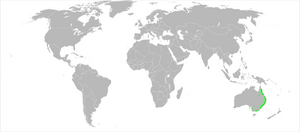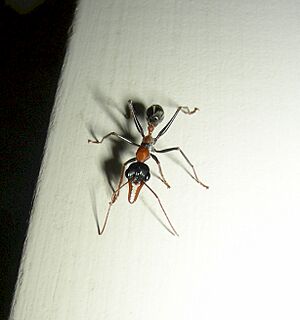Jumper ant facts for kids
Quick facts for kids Jumper ant |
|
|---|---|
 |
|
| Close up head detail of M. nigrocincta | |
| Scientific classification | |
| Genus: |
Myrmecia
|
| Species: |
nigrocincta
|
 |
|
| M. nigrocincta is mainly endemic to the eastern coasts of Australia. | |
The Myrmecia nigrocincta, often called the jumper ant or jumping jack, is a fascinating ant from the Myrmecia group. Frederick Smith first described this ant in 1858. You can find many colonies of these ants in eastern Australia.
These ants are famous for their amazing ability to jump up to 10 centimeters (about 4 inches)! They also have a strong, venomous sting. Instead of looking for food on the ground, M. nigrocincta ants prefer to search in trees. They even help pollinate some flowers there.
This ant is quite large. Some worker ants can grow to be over 15 millimeters (0.6 inches) long. They have a special pattern of orange-red and black colors. This helps tell them apart from other Myrmecia ants. M. nigrocincta ants have a special gene called gamergate. This allows worker ants to lay eggs and reproduce. This can happen even if there is no queen in the colony. A worker ant can live for over a year. These ants are also known to take over other ant species to work for their colony. They are very aggressive when they attack unwanted visitors.
Contents
Where Jumper Ants Live
M. nigrocincta ants are common in eastern Australia. They like temperate bushlands, especially dry or semi-dry forests. You can mostly find them on the coastal plains where there is a lot of dry forest habitat. They prefer warm, tropical climates. These ants can also live in other places, from 80 to 1,220 meters (262 to 4,000 feet) above sea level.
Jumper ant colonies have been found in many places in Queensland. These include Cairns, Atherton, Mackay, Mt. Tamborine, Brisbane, Blackall Range, and Fletcher. In New South Wales, they live in Lismore, Dorrigo, Armidale, and Sydney. In Victoria, you can find them in Trafalgar and Millgrove. Some colonies have also been seen in South Australia.
Jumper Ant Features
Ants in the Myrmecia group are often called "bulldog ants." Like other ants in this group, M. nigrocincta has long mandibles (jaws). These ants are mainly black and orange-red. Their mandibles can be black or yellow, depending on where the ants live.
The main body parts like the gaster (abdomen), head, and legs are black. Other parts like the pronotum (front part of the thorax) and petiole (waist) are red. The ant has small ridges on the front of its head. Its legs are thin and get narrower away from the body. You can tell M. nigrocincta apart from other Myrmecia species by its two-colored body. The thorax and post-petiole are yellowish-red and black, and the node (a part of the waist) is yellowish-red.
Worker ants are usually 13 to 15 millimeters (0.5 to 0.6 inches) long. Males are a bit bigger, from 16 to 17 millimeters (0.6 to 0.7 inches). The female queen ant is the largest, at 17 to 19 millimeters (0.7 to 0.75 inches). Queen ants have small, undeveloped wings. This means they cannot fly.
Jumper Ant Behavior and Life
M. nigrocincta is an excellent jumper. It can leap about 3 to 4 inches (7.6 to 10 cm). These ants have good eyesight. You can often see them running among plants and leaves. Sometimes, they jump from one branch to another. They mostly look for food on plants and trees, but sometimes on the ground too. They jump by quickly extending their middle and back legs.
M. nigrocincta ants are diurnal, meaning they are active during the day. They do not hibernate (sleep through winter). They are omnivores, which means they eat both plants and animals. Their diet includes other insects like caterpillars and spiders, as well as honey water. Jumper ants have been seen hunting the larvae (young) of imperial hairstreak butterflies. They even jump while carrying them!
Spiders, birds, lizards, mammals, and other insects like assassin bugs and redbacks hunt M. nigrocincta ants. These ants have been seen visiting the flowers of Eucalyptus regnans and Senna acclinis trees. They might help pollinate E. regnans trees. However, they may not be able to properly release pollen for Senna acclinis.
These ants build their nests in sandy soil. Sometimes, their nests have a small mound, like a molehill. M. nigrocincta ants work hard to hide their nests using twigs and leaves. They decorate their nests with plant material and gravel. Other things they use to hide their homes include dry leaves, rocks, and small branches. Nests are usually found next to a clump of grass or a bush, or at the base of a tree.
M. nigrocincta ant colonies are monogyne. This means they have only one queen per colony. The queen is semi-claustral. This means she has to leave the nest to find food when she is starting a new colony. This helps her feed her young. Colonies can have between 400 and 1200 ants, which is considered a large colony. M. nigrocincta is known to enslave Leptomyrmex and other ant species.
Worker and scout M. nigrocincta ants use special chemicals called pheromones to talk to each other. They quickly defend their nests. They might even react aggressively if a shadow crosses their nest. One scientist described their reaction to a disturbed nest: "they bound out of their small mound nest in a series of short hops like Lilliputian cavalry galloping to battle." These ants bravely protect their colony. They will sting many times and even sacrifice themselves to keep the queen and the colony safe.
Jumper Ant Life Cycle
M. nigrocincta is a gamergate species. This means that female worker ants can lay eggs and reproduce. This happens in colonies with a queen and even in colonies without a queen. So, if a colony loses its queen, it can still survive and grow. In lab studies of M. nigrocincta colonies without a queen, worker-laid eggs grew into adult males. This shows that the workers are very fertile.
An adult worker M. nigrocincta ant usually lives for about 1.1 to 1.2 years. The longest they can live is about 1.3 years (over 400 days). Young ants (larvae) collected from M. nigrocincta are about 4.7 millimeters (0.18 inches) long. They grow to about 9.7 millimeters (0.38 inches) when they are fully grown.
Jumper Ant Sting
M. nigrocincta ants have very venomous stings. Their sting is painful and causes a strong burning feeling. This feeling can last for many days, and the sting site will itch. If not treated, the sting might turn into an ulcer.
The venom of a related ant, the M. pilosula, is one of the strongest among all ants. It contains chemicals like acids and enzymes. In a 2011 study about ant sting allergies in Australia, scientists wanted to find out which native Australian ants caused severe allergic reactions (anaphylaxis). Out of 376 people in the study, 265 reacted to the sting of several Myrmecia species. Of these, 176 reacted to M. pilosula, and 15 reacted to M. nigrocincta. The study found that four main groups of Australian ants cause severe allergic reactions. Besides Myrmecia species, these also included the green-head ant (Rhytidoponera metallica).
See also
 In Spanish: Myrmecia pilosula para niños
In Spanish: Myrmecia pilosula para niños



